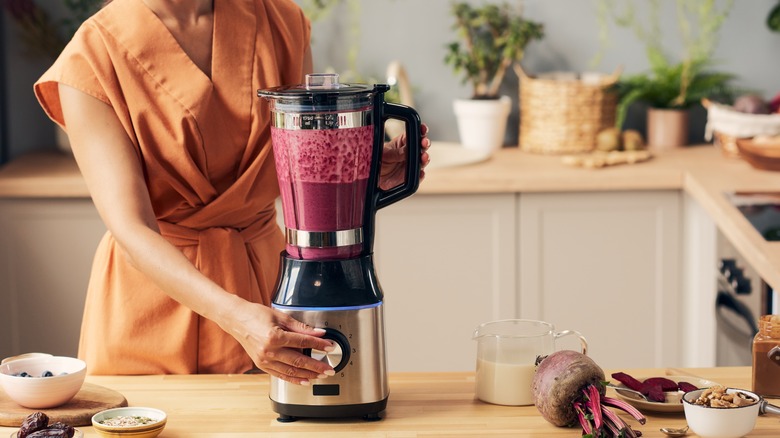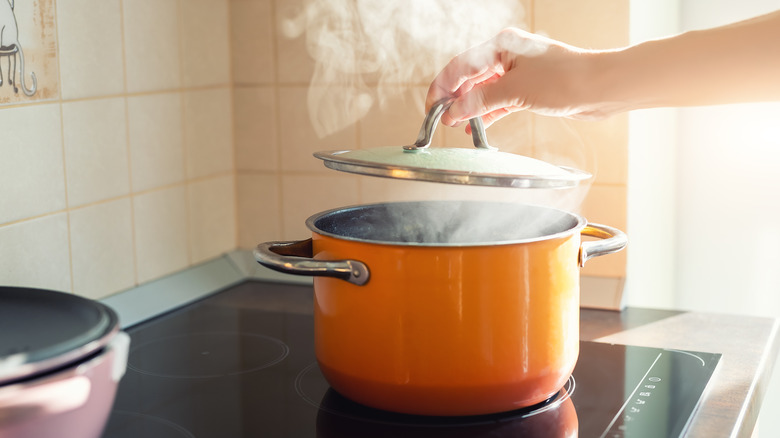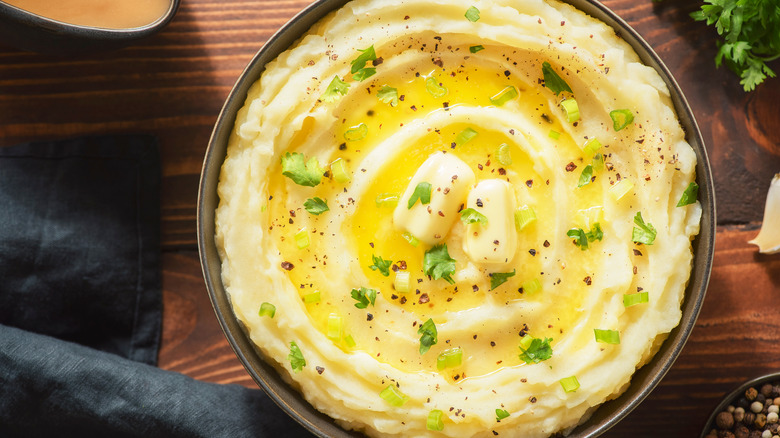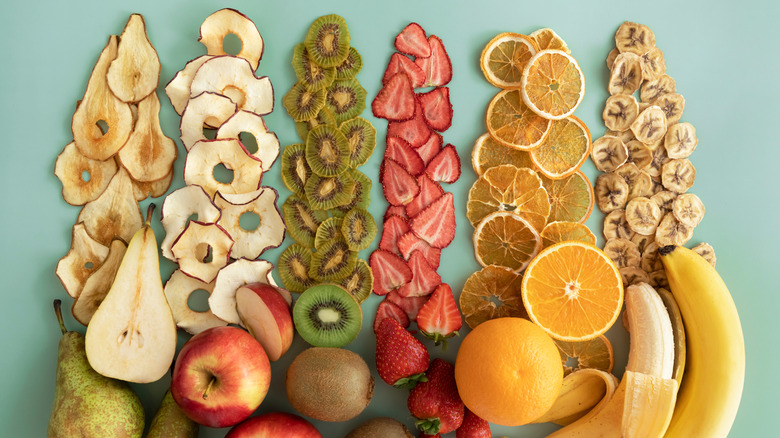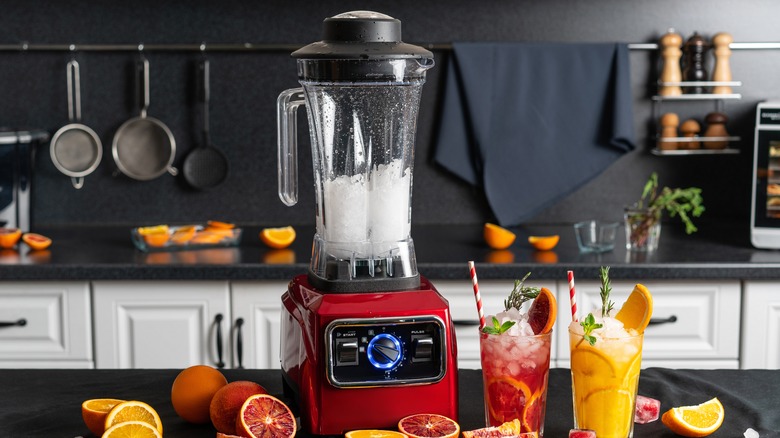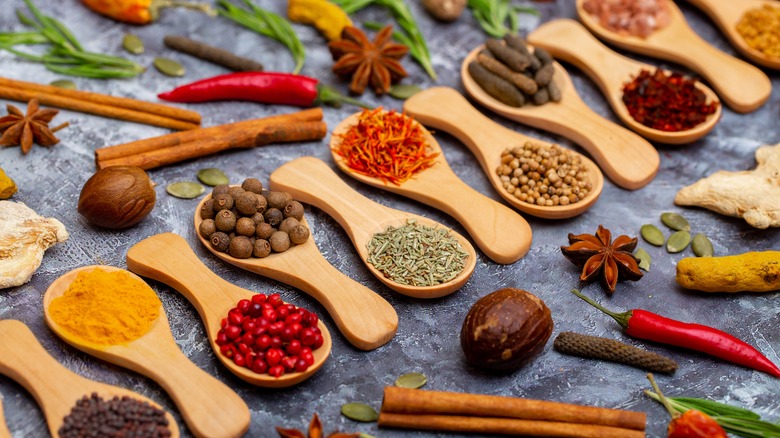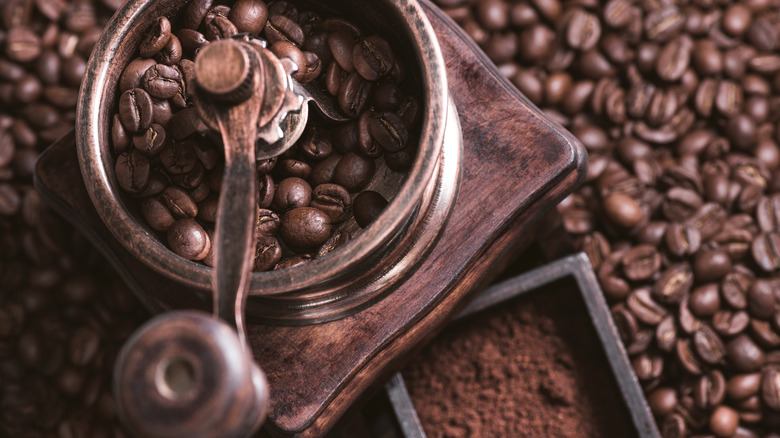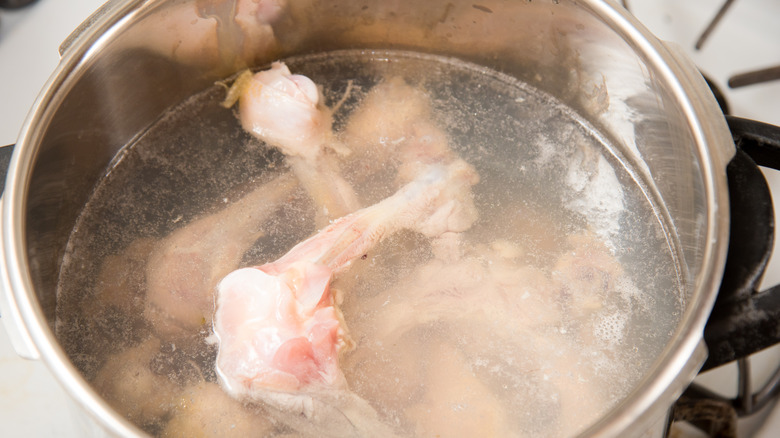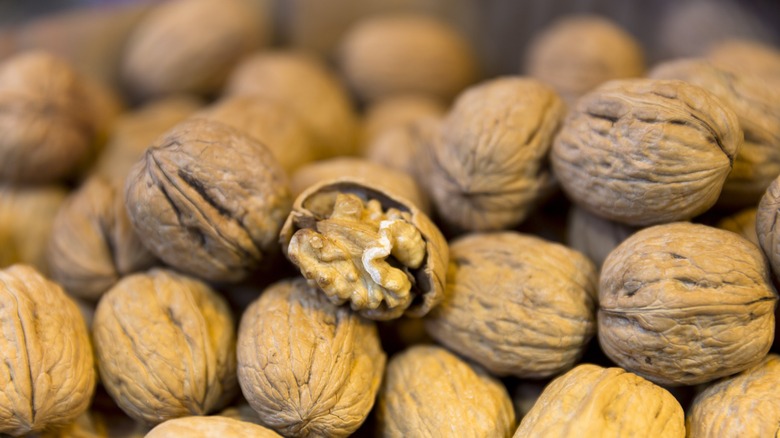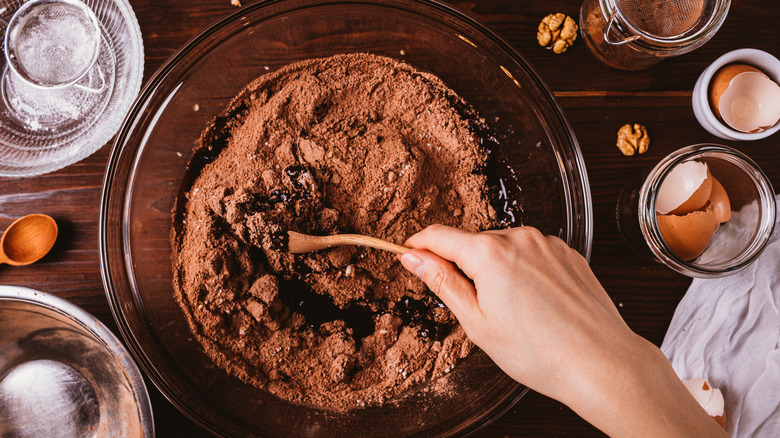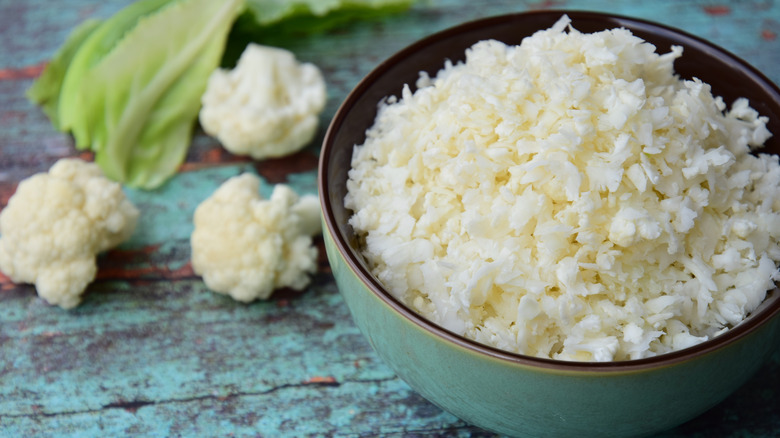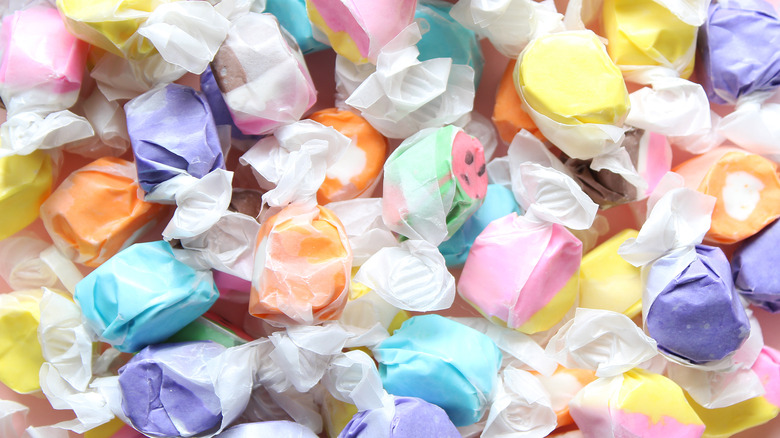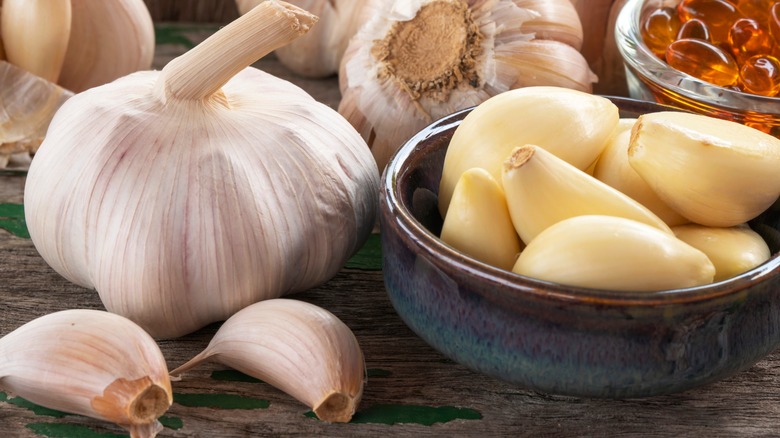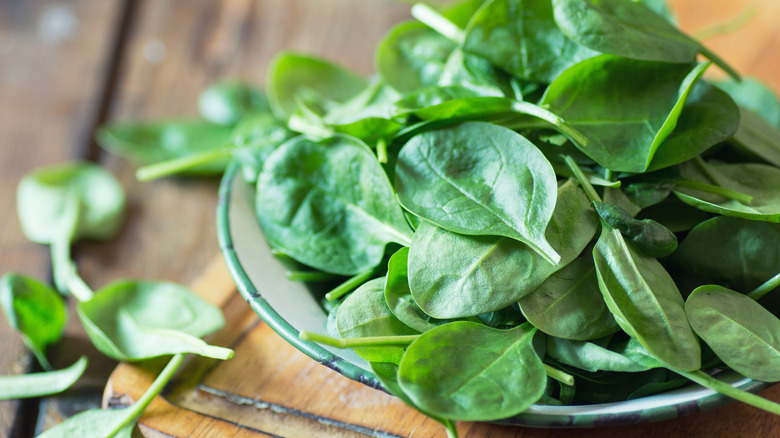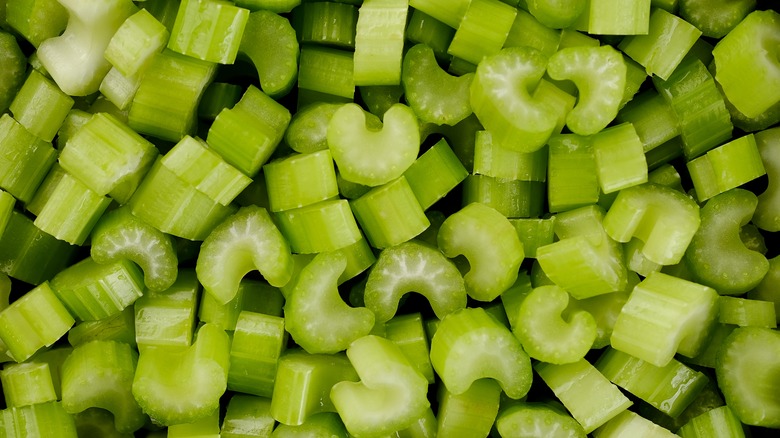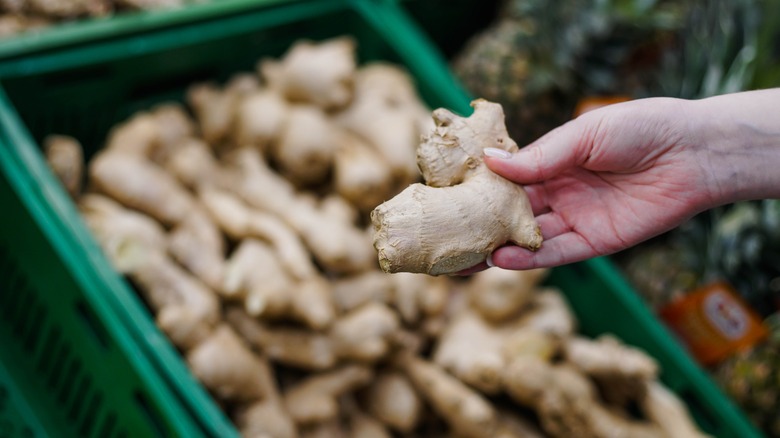15 Foods You Should Avoid Putting In A Blender
Making a sauce, smoothie, or soup? You may be tempted to reach for your blender to create a smoother consistency. However, while your countertop blender does come in handy in a variety of situations, it might not always be a good pick for every single recipe. In some instances, throwing certain ingredients in a blender can result in injury to yourself or the blender, undesirable textures, or even a change in ingredient color. Sometimes, you're best off opting for using an immersion blender, food processor, or just a good, reliable kitchen knife instead.
To help you get the best results in the kitchen, here are some of the top foods you should avoid putting in a blender. You might also find a few tips for how to get that blended consistency you're looking for sans this popular countertop appliance. Already blended one of the items on our do-not-blend list? We have a few tricks for remedying popular blender blunders as well.
1. Hot liquids
Have you ever attempted to blend a liquid mixture, only for that mixture to go shooting out of the blender and all over your kitchen because you forgot to attach the blender lid? It probably made a major mess and potentially covered you in half-blended goop. Now, imagine if that liquid mixture was a piping-hot batch of soup. You can probably picture the painful results. However, you might think that as long as you always remember to tightly affix the blender lid every time you blend a hot liquid, you'll be safe. Well, not really.
When you take hot, steaming sauces or soups from the stove, pour them into your blender, and blend away, the steam can build up beneath the lid to such a degree that the lid pops off on its own. This will also allow your blender to shoot its contents all over your kitchen. If you do want to blend hot liquids, consider using a hand or immersion blender, cool the contents down before blending and then reheat them, or purchase a specialized blender with a venting lid to prevent a steam-backed explosion (via Kitchen Aid).
2. Potatoes
If you're making mashed potatoes but don't own a stand mixer, and you don't want to put in the effort mixing by hand, then you might assume your best option is to reach for your blender. After all, your blender can turn fresh fruits and veggies into smoothies, so why couldn't it turn cooked, soft potatoes into equally smooth mashed potatoes?
Unfortunately, while this makes logical sense, blended potatoes end up with a consistency similar to paste, and it's all because of the high starch content in potatoes. One Reddit user discovered this the hard way, creating a thick pasty mixture. In the forum asking culinary experts for advice, one commenter explained, "starch molecules ... keep potatoes fluffy and light. The blender has burst those starch molecules and has transformed them into a thick gummy paste that can't be rescued."
In contrast, a gentler potato masher leaves those molecules intact. The general consensus on the thread? If you've already made the mistake of blending your potatoes, your plans for mashed potatoes are out the window. You'll want to repurpose the potatoes another way, making potato soup or potato pancakes.
3. Dehydrated fruit
Dehydrated fruit can replace fresh fruit in plenty of situations. That's especially true if you're the type to buy fresh fruit, store it away in the fridge, and then come back a month later to find the fruit rotten in the bottom of your produce drawer. Whether you use dehydrated fruit for snacking, on your cereal or granola, or even on top of a cake, there's one place where you shouldn't swap it for fresh fruit: your blended smoothie.
Dropping dehydrated fruit in a blender can make for a sticky mess, with the dry fruit adhering to the blades. If you absolutely must blend it, rehydrate it first with a quick soak. If you're trying to make a fruit powder from your dehydrated fruit, like to upgrade the color and flavor of your buttercream frosting, skip the blender and use a coffee or spice grinder instead — both of which provide a finer texture.
4. Frozen anything
Okay, you've probably thrown frozen items into a basic countertop blender before. Whether it's ice for cocktails or frozen fruit for a smoothie, the blender is a go-to tool if you want to crush up that frozen food. However, while it might be common practice, blending anything frozen can damage the standard blender. This is why you may have smelled smoke the last time you mixed up a batch of margaritas. And yes, that smoky smell is something to worry about, so don't just ignore it. Most blenders aren't built with the motors and power necessary for that type of work.
If you really want to blend ice or other frozen foods, you'll need to invest in a top-of-the-line blender that can handle it or, conversely, use a food processor, which is generally better for hard ingredients. Food processors are also superior to blenders when it comes to crushing ice, as they allow you to better control the size and texture of your processed ingredients.
5. Spices
Toasting and grinding spices fresh at home can produce a more concentrated, fresher flavor that takes a dish up a notch. However, grinding spices at home requires some special equipment. While you technically can grind spices in your blender, it's not ideal, as you won't be able to achieve a fine grind. Using a food processor, chopper, or blender to grind spices can take a long time as all of these countertop appliances use large blades over a large surface area. Most herbs are pretty small, making it more difficult for the blade to grind all of them quickly and efficiently.
If you want to toast and grind your own spices, your best bet for the finest texture and quickest, easiest grinding process is a dedicated spice grinder. This grinder is small and designed to uniformly reduce small items like peppercorns or cardamom to a fine powder. You can also use a dedicated mortar and pestle, but that won't be as fast or efficient.
6. Coffee beans
Just as a traditional countertop blender can't give you a uniform texture when grinding spices, it also won't give you a consistent texture when grinding coffee beans. You might not think this is a big deal; you're just tossing the freshly ground coffee beans into your percolator, French press, or Chemex. Although you may not be eating the beans, achieving a uniform grind is vital to brewing the perfect cup of coffee.
Your coffee's grind size impacts the extraction rate, or how fast flavor and caffeine can be extracted from the coffee. A finer grind equals faster extraction, while a coarser grind equals slower extraction. However, if your coffee is unevenly ground, with a mix of small and large pieces, then there's no consistency, meaning your cup of joe will taste a little off, no matter how you brew it. For the most uniform grind in your coffee, use a burr grinder.
7. Bones
It should not need to be said, and yet, we're saying it. If a blender can't properly blend hard ingredients like frozen food or ice, how will it stand up to a bone? Surprisingly, a quick search online shows lots of folks turning to the internet with questions about putting bones in their blenders.
Well, various recipes actually call for blending up bones or bone-in meat. In other cases, people may be looking for ways to make bone-based fertilizer for their gardens, which can boost soil phosphorous levels and feeds plants organically. And finally, some people are chowing down on chicken bones as part of the keto diet.
Regardless of the intentions, though, please do not blend your bones. Not only can most blenders not handle them, but, if the bones are not blended finely enough, you could end up eating a particularly sharp shard of bone, which can, under the worst circumstances, puncture your intestines (via the University of Utah Health).
8. Nuts and seeds
If you've ever attempted to crush nuts by hand for a recipe, you've likely realized how difficult it is. Luckily, some simple chopping will give you the rough texture you might need to add nuts and seeds to baking recipes. However, if you're hoping for a super creamy, smooth texture — like making homemade peanut butter — you might turn to your blender. Before you do, though, you'll want to consider a few things.
If you use just any blender, you'll damage both your motor and blades. Because nuts and seeds are pretty hard to crush, you'll only want to use a high-powered blender that's built for this type of work. Look for a high-wattage blender that comes with nut butter-specific blades. You can also opt to blend softer nuts like cashews only after they've been soaked for a while, rendering them even softer. Consider ditching the blender entirely and going the safest route by making nut butter in a food processor.
9. Dough
So you're mixing up a batch of cookie dough, or maybe you need to cut butter and flour together to form a sandy consistency for pastry dough. Whatever the case may be, there's some mixing that needs to be done, and you may not have time to do it the old-fashioned way. If you don't have a handheld or stand mixer, you might think your blender could do the trick.
However, a blender is not ideal for mixing any sort of dough. The shape of the blender blade and the body isn't suitable for dough mixing. If you want to mix the dough but you don't have a mixer, consider using a food processor instead of a blender, but only for pastry doughs that combine butter directly with dry ingredients. A bladed appliance isn't going to work well with heavier doughs of any type, so you're better off using a mixer, or if need be, you can do it manually.
10. Cauliflower
Perhaps you jumped on the cauliflower trend over the last few years and started using cauliflower in all sorts of new places. Maybe you've had it as pizza crust or as a stand-in for rice. If so, you may have struggled to break the vegetable down into the necessary crumbly consistency. You typically want the cauliflower to remain slightly chunky, especially if you're using it in a recipe that demands texture, as is the case when making riced cauliflower.
If you were thinking of breaking down your cauliflower in your blender, you'll want to think again. Your blender is more likely to turn your cooked cauliflower into a puree than anything else. Opt to break down cauliflower in a food processor for more precise control over the resulting texture. A food processor is your best choice for processing anything that should remain slightly chunky, like riced cauliflower or tabbouleh. Leave the blender for pureeing or emulsifying.
11. Homemade taffy
If you've ever made a homemade candy like taffy or even watched taffy being made at a candy shop, then you likely know that a fair amount of hands-on work goes into the process. Pulling taffy is a labor-intensive ordeal but absolutely necessary if you want a chewy, opaque, air-filled treat. However, while a candy shop might have the machinery to do the work, if you're making taffy at home, it's all going to be up to you.
Home cooks might be tempted to toss their taffy in a blender and let the countertop appliance take things from there — pulling, pushing, and twisting the taffy until it's done. However, taffy starts out hot and very sticky, meaning it's just going to gum up in your blender blades and create an inedible mess. This is one thing you'll have to do the old-fashioned way unless you want to invest in a taffy-pulling machine for those rare times you get a craving for taffy.
12. Garlic
So, you're making a sauce or salsa in your blender. You toss in a few cloves of garlic, along with your other ingredients, and blend away. After you're done, you clean and put away your blender. The next morning, you get up to make your daily fruit smoothie, and your blender reeks of garlic.
Well, that's because garlic is one of those ingredients that lingers just about anywhere you put it, including in your blender. If you use your blender regularly and most often for sweeter rather than savory recipes, you might want to save yourself a headache by not exposing your blender to garlic at all.
Already blended some garlic and now struggling with getting rid of the smell? Try blending a mixture of water, vinegar, and lemon or lemon juice, before re-washing the blender and letting it air out. However, even with steps like these that can help remove most unpleasant smells, the garlic aroma may still bind to any stainless steel blender parts, and it simply takes time to go away.
13. Room-temperature greens
You probably know that if you cut an apple or banana and leave it on the counter, the fruit will turn brown pretty quickly. But what about your spinach or other leafy greens? While greens won't turn brown on the counter, they will change in your smoothie — as is the case with bananas and apples, it's all due to science. When chlorophyll-packed greens react to heat, chlorophyll molecules break down, and the greens change color. As a result, turning kind of a brownish or gray-green color. Turns out, your blender can produce just enough heat to start this chemical reaction.
If you want to prevent your greens from turning an unsightly hue the next time you blend them, you can delay this chemical reaction by not adding warm, room-temperature greens to your blender. Instead, only add refrigerated greens, as the blender's motor heat won't be quite enough to thaw out the greens and break down that chlorophyll.
14. High-fiber foods
If your recently blended veggie-based smoothie came out a little stringy, it could be because you're adding raw, high-fiber foods to your blender. While blenders are great at obliterating many fruits and vegetables, they often struggle with the fine-cutting technique needed to cleanly and quickly separate stringier, more fibrous foods, such as celery.
If you want to add these foods to your next smoothie, sauce, or soup, or whatever else you plan to blend, you don't have to refrain from using your blender completely. Just don't add them to the blender raw. Chop and cook them beforehand. You'll avoid any stringy gunk in your smoothie, and you'll keep your blender's blades sharper for longer.
The good news? Even when you do put high-fiber foods in a blender or another similar device, like a juicer, the blending process won't reduce the amount of fiber in your foods, which is often a concern for those who picked up a blender recently to help develop healthier habits.
15. Ginger
If you've tried to make ginger juice or a ginger shot using your blender, you've likely been quickly deterred by the blender's struggle to achieve that desired blended consistency. The root is just too hard and stringy for most blenders to handle.
Because of this, if you're aiming for chopped ginger, you're best off just chopping it on your own. If you're trying to make ginger juice or a ginger smoothie, you'll want to chop or grate the ginger first. Once the ginger is ready, you can add it to your other ingredients and throw it in the blender.
Whatever you do, don't throw the ginger into the blender whole. Trim it, peel it, and then mince the ginger by hand so that you get the ginger in whatever you're making, and so the blender doesn't need to do any of the work. You can also use a food processor to chop or grind pieces of ginger that are too large for your blender to handle if you don't want to do any chopping on your own.
